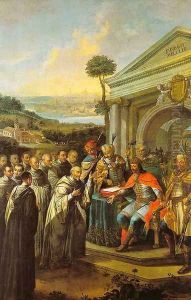Istvan Dorfmeister Paintings
István Dorfmeister was a prominent Hungarian painter born in 1729 in Bratislava, then part of the Habsburg Monarchy and now the capital of Slovakia. His work is often associated with the late Baroque and early Neoclassical periods, reflecting the artistic transitions of the 18th century. Dorfmeister's contributions to art were significant in the context of Central European painting, where he developed a distinct style that merged regional artistic traditions with broader European influences.
Dorfmeister's training and early career were marked by extensive travel, which was common for artists of his time seeking to broaden their skills and perspectives. He studied at the Academy of Vienna, a leading art school that attracted students from across the continent. This education provided Dorfmeister with a solid foundation in the techniques and styles prevalent in European art, particularly those emanating from the influential circles in Vienna and Italy. His work, however, retained a unique character that reflected his personal vision and the cultural milieu of his homeland.
Throughout his career, Dorfmeister was best known for his religious and portrait paintings. His religious works often adorned churches and cathedrals in Hungary and Slovakia, showcasing his ability to convey spiritual themes with depth and emotion. These pieces are characterized by their detailed depiction of biblical scenes, executed with a mastery over color and composition that brings these narratives to life. Dorfmeister's portrait paintings, on the other hand, reveal his keen eye for detail and an exceptional ability to capture the personality and stature of his subjects. His portraits of nobility and prominent figures of the time are particularly noted for their elegance and realism.
Dorfmeister's legacy is that of a key figure in the Central European art scene of the 18th century, whose work bridged the gap between the Baroque's emotive expressiveness and the emerging clarity and simplicity of Neoclassicism. His paintings are preserved in several European museums and churches, serving as a testament to his skill and artistic contribution. István Dorfmeister died in 1797, leaving behind a body of work that continues to be studied and admired for its historical significance and artistic merit.
